To be honest I was not sure what I would find as I began my search for the Welsh poet, Dylan Thomas in his home town of Swansea. The city’s heart was bombed in the blitz and rebuilt with the usual post-war lack of charm, with characterless office blocks, high street shopping and more than its fair share of kebab and pizza takeaways.
Even Dylan Thomas spoke of Swansea in one of his radio broadcasts as “an ugly, lovely town, as it was and is to me.” On past visits to see my son at Swansea University (where we joked that he majored in Surf studies) we’d bypass the city centre in favour of the seaside promenade of Mumbles and the glorious beaches of the Gower. But this weekend was my opportunity to re-discover Swansea through the eyes of its most celebrated son, Dylan Thomas, the literary rock star of his day.
This article may contain affiliate links that provide commission on purchases you make at no extra cost to you. As an Amazon Associate I earn from qualifying purchases.
We’d checked into the Morgans Hotel, where the turn of the century Harbour Trust Office has been converted into a smart hotel. To start our Dylan Thomas trail, it was a short walk in the direction of the Marina to the Dylan Thomas Centre, which houses a permanent free exhibition about the life and works of Dylan Thomas.
While waiting for the centre to open we had a chance to stroll around the Marina which was looking very fresh and new in the morning sunshine, surrounded on all sides by new apartment buildings. Regeneration was clearly well underway in Swansea, although from the empty shops and restaurants on the quayside it seemed that the local economy hadn’t quite caught up with this ambitious project.
The Dylan Thomas Centre
At 10am the doors opened and we entered the free exhibition area of the Dylan Thomas Centre, with its wall sized photo murals of Dylan, his friends from the Swansea literary scene and a portrait of his wife Caitlin painted by Augustus John. Voices from the actors who had worked with him were captured on video and periodically the breathy, booming, cultivated voice of Dylan from one of his radio broadcasts, filled the room.
Born in 1914 into an upper middle class Swansea family, Dylan must have soaked up a love of literature from his father, DJ Thomas, who was Head of English at Swansea Grammar School, as well as a lyric chapel style from his uncle who was a preacher. He had a precocious talent, writing two thirds of his published poems and stories in his teens, working in his tiny bedroom at 5 Cwmdonkin Drive, that we were to visit later that day.
As a teenager, Dylan and his friends would hang out at the Kardomah cafe in the centre of Swansea, a group of talented young men who later became composers, writers and artists, known as the Khardomah gang. After leaving the Grammar, he worked as a junior reporter at the South Wales Daily Post in Swansea, before moving to London where he met Caitlin Macnamara in the Wheatsheaf pub in 1936.
Caitlin was an Irish dancer, living the bohemian lifestyle, and a friend of Augustus John, who painted her several times. Dylan and Caitlin married in 1937 and living an itinerant lifestyle, moving between London and Wales with their three children. Throughout the Second World War, Dylan who was exempt from active service on account of his asthma, wrote film scripts for wartime propaganda films.
After the war, Dylan Thomas found fame through his radio broadcasts and tours of America, becoming one of the first multi-media stars, receiving the same adulation as the rock stars that came after him, with his drinking and infidelities causing storms in his marriage.
It was on a final American tour to New York, embarked on for the money and to escape the rows with Caitlin, that Dylan collapsed, fell into a coma and died at the age of only 39. The causes of his death have not been fully explained but were probably a combination of pneumonia, undiagnosed diabetes, an overdose of morphine and asthma not to mention the effects of hard drinking. His final words (the only thing my teenage son could tell me about Dylan) were; “I’ve had 18 straight whiskies.. I think that’s the record”.
For a long time Dylan Thomas’ reputation was bound up with disapproval of his drinking and womanising, but in the centenary year of his birth, the pendulum seems to have swung back to an appreciation of Dylan’s poetry, short stories and radio plays such as Under Milkwood. His poetry is all about the lyrical sounds of words, combined with keen observation of the characters he knew from growing up in Swansea and his time in South Wales.
In his Poetic Manifesto, he wrote; “I wanted to write poetry in the beginning because I had fallen in love with words, I cared for the colours the words cast on my eyes” and he constantly told the actors he worked with on his radio plays to “love the words”. One of the exhibits in the centre that caught my eye was the lists of words that Dylan made in his notebooks like a shopping list, ready to use in the appropriate poem, and the words were on a magnetised board to allow you to compose your own sentences or poems from them.
In the second exhibition room were pen and ink drawings of Dylan by Peter Evershed, made during his literary tours of America, and a beautiful mural of the characters of Under Milkwood, his play for voices based on the Welsh characters he had observed growing up. The intricately drawn mural was painted by Vic Bowcott who would listen to each part of the play and then commit his ideas to paper to capture all the scenes and characters.
Visitor Information: Dylan Thomas Centre, Somerset Place, Swansea, SA1 1RR Open 10am-4.30pm Free permanent exhibition and literary events throughout the year.
Promenade Performance of Return Journey
Since this year is the centenary of Dylan Thomas’ birth, there are numerous plays and literary events during 2014 as part of the celebrations. I’d spotted that there was a Promenade Performance of Return Journey taking place on the weekend we were visiting, starting at the Dylan Thomas Centre, so we’d reserved tickets. Better than any city tour, this was a performance of the radio play that Dylan wrote about his return to Swansea after the blitz, searching for the places he knew and the boy that he once was.
For two hours the audience walked around the streets of Swansea, stopping at the places Dylan Thomas had been to school, worked as a reporter, or drunk in the pubs, while the five actors of the Lighthouse Theatre Company performed parts of the play in 1950s costume. The props and scenery were the benches, shops and office steps of central Swansea and we had to re-imagine most of the places that Dylan knew since they had been destroyed by the wartime bombing. On the nights of 19-21 February 1941, in what became known as the three-night blitz, incendiary bombs rained down on Swansea, flattening 41 acres of the city centre.
Walking up from the Marina we crossed the busy main road into Wind Street where we could observe what remained of the confident Victorian and Edwardian buildings of Dylan’s youth. As we stood in Castle Square, we had to visualise the old South Wales Daily Post offices where Dylan worked as a reporter, opposite the ruins of the medieval Swansea castle. Close by was the spot where the Three Lamps pub stood, where Dylan enjoyed a drink after work or even when he should have been working, since his job gave plenty of opportunity for skiving when he should have been scouting out a story. In Return Journey, Dylan writes of the scene that greeted him as he surveyed the centre of Swansea after the three-night-blitz;
” It was a cold, white day on High Street, and there was nothing to stop the wind slicing up from the docks, for where the squatt and tall shops had shielded the town from the sea, lay their blitzed, flat graves, marbled with snow, and head stoned with fences. Dogs delicate as cats on water as though they had gloves on their paws, padded over the vanished buildings…The wind cut up Wind Street with a soft sea noise, hanging on its arm like a hooter, with a muffler. I could see the swathed hill, stepping out from the town, where you could never see it clearly before… Crushes of shopping women, crunched up the little grey drab street, and they blew and they queued, and they yearned for hot tea, as I began my search along Castle Street in Swansea town on that cold and wicked February morning “
The play continued as we stopped near the old Bush Hotel where Dylan asks the regulars propping up the bar whether they remember his younger self, who had once drunk here. This is how he describes himself to them;
” Young Thomas, He’d be about 17 or 18, and above medium height, well above medium height for Wales, I mean. He’s 5ft 6 1/2, thick blubber lips, curly mouse brown hair, one front tooth broken after playing a game called cats and dogs in the Mermaid in Mumbles, speaks rather fancy, truculent, plausible, bit of a shower-off, plus fours, no breakfast, you know?”
Already a pattern was emerging of a boy who had a way with words and was ambitious to make his way in the world through them, who was a keen observer with an eye for the comedy of everyday life and who was ready for the the warmth and camaraderie of a pint in the pub at any time of day. Our performance moved on to the Mount Pleasant Baptist Church which was one of the few buildings to survive from the blitz, standing like a lone pillar in the midst of the destruction.
Here we heard about Dylan’s teenage years at the Grammar School when he gathered with his friends in the Khardomah cafe; “drinking coffee dashes and arguing the toss. Music and poetry, paintings and politics, Einstein and Epstein, Stravinsky, Greta Garbo, death, religion, Picasso and girls.”
We drew close to what remains of Swansea Grammar school , now part of Swansea Metropolitan University, where Dylan’s father DJ Thomas was Head of English. In Return Journey his schoolmaster remembers Dylan and thousands like him;
” He looked much like most boys – he could could assume righteous indignation. He appeared regularly on Wednesdays in detention and hid in the cloakroom during algebra. He was 33rd at trigonometry though as might be expected he edited the school magazine. “
We walked up Walters Road, heading towards Uplands and Dylan’s childhood home, passing a succession of pubs, which would have been even more numerous in Dylan’s day. After his death Dylan’s reputation as a drinker overshadowed his reputation as a poet, but in the early years he was more in love with the camarardarie of the pub, the chance to participate in a man’s world, not to mention the taste of beer. He wonders what his father would think of him standing in the bar, between an alderman and a solicitor;
“He could not fail but to be angry at the angle of my hat, and my fag and my clutched tankard. I liked the taste of beer, I loved its brass bright depths, the warm gushing down to the belly, the swallowing down, the lapping at the stomach, the salt on the tongue, and the froth on the lips. Same again Miss – I said to the barmaid.”
On our way to Uplands, we heard stories of how Dylan had mooched around in the sand dunes by the sea shore watching the tankers, tugs and banana boats come out of the old docks. He’d swagger along the prom whistling after the girls who would brush him off and feign disinterest; “Mr Cheeky, with your cut glass accent and your father’s trilby” In a quiet residential street, we passed the Dame School, a small primary school in a private house where the boys would play in the narrow lane behind the school and ” the oldest and boldest threw pebbles at windows, scuffled and boasted, lied about their relations… then they smoked the butt ends of cigarettes, turned green, went home and had little appetite for tea.”
The audience reached the Grove in Uplands near the “fleapit picturehouse”, now a Lloyds Bank where he “whooped with the scalped Indians” and bought gobstoppers and sweet surprises. Then we went into Cwmdonkin Park, within sight of his childhood home where the park-keeper in Return Journey remembers the young Thomas;
“he used to climb up the fence by the old reservoir and pelt the swans, run like a billy goat over the grass which you should keep off. Pull branches off the trees, have words at the benches, climb up the elms and moon like an owl, fight in the bandstand, set fire in the bushes, play on the old green bank, Ah yes, I knew him well, I think he was happy most of the time. I knew him by the thousands.”
Our promenade performance ended in Cwmdonkin Park and we all applauded the actors of the Lighthouse Theatre Company who had entertained us with an insight to both Swansea and the life of the young Dylan Thomas growing up in this town. Through his own words in Return Journey I was getting to know Dylan better, with his keen comic observation of character and mocking of his younger self, a boy like a thousand others who grew up to become Wales most celebrated modern poet.
Visitor Information; There are further performances of Return Journey by the Lighthouse Theatre Company on 5/6 July, 2/3 August, 6/7 September 2014, which can be booked through the Dylan Thomas Centre, Tickets £9. This is only one of the numerous literary events in 2014 to commemorate the Dylan Thomas Centenary.
Since this article about our day in Swansea was becoming unfeasibly long, I’ve divided it into two parts. Read about Part 2 of our day in Swansea in which we visit the birthplace of Dylan Thomas at 5 Cwmdonkin Drive
All my articles about Dylan Thomas
An ugly lovely town Part 1 – a Return Journey to Swansea with Dylan Thomas
An ugly lovely Town Part 2 – the Dylan Thomas birthplace in Swansea
Lovely Laugharne – on the Dylan Thomas Trail in South Wales
For more information on everything to see and do in Wales check the official website at Visit Wales
For more information about Dylan Thomas on the official Dylan Thomas Website. For more information about things to do in and around Swansea including the Dylan Thomas attractions visit the Visit Swansea Bay website
We stayed at Morgans Hotel in Swansea
While in Swansea we stayed at Morgans Hotel, that has been converted from the Harbour Trust Office. The building was completed in 1902 and is a grand reflection of the confident Edwardian era when Britain ruled the waves and Swansea was a great port and industrial powerhouse, known as “Copperopolis” due to the large amount of Copper smelted there. Our large corner bedroom looked as if it had once been an executive office with high ceilings and plaster mouldings and was named Sketty Belle after one of the Swansea ships of the period. Heavy mahogany doors and arched windows were complemented by a pale green colour scheme with cream brocade curtains.
The bedroom was well equipped with fridge, kettle and trouser press and an enormous dark wood TV stand. The bathroom was full of marble and limestone, with a brilliant rainforest shower over the bath, although the glass shower screens made it a bit awkward to lie down in the bath. Lots of nice Molton Brown toiletries made us feel very pampered. Downstairs at the entrance was a very stylish bar area with leather sofas, ideal for a cocktail or pre-dinner drink. The restaurant upstairs where we had breakfast was in a magnificent room, formerly the banking hall of the Harbour Port Office, with original maritime mural over the entrance and copper globe lamps which recalled Swansea’s industrial heyday.
I’d highly recommend Morgans Hotel as a place to stay if you’re looking for a luxurious hotel as a base for exploring Swansea and the Dylan Thomas trail.
Morgans Hotel, Somerset Place, Swansea, SA1 1RR. Book online or phone 01792 484848. The Sketty Belle room £175 per night, other rooms from £125 or from £90 in the adjoining townhouse
Our thanks to Visit Wales who hosted* our weekend in Wales discovering Dylan Thomas
* More info on my policies page
This article is originally published at Heatheronhertravels.com

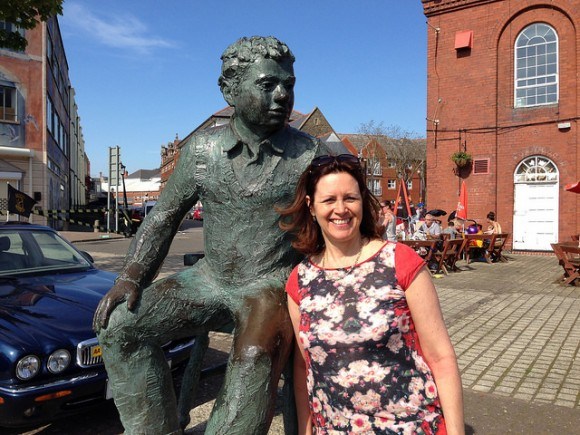
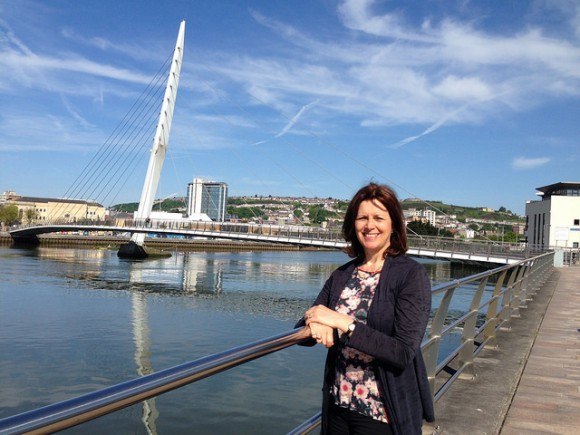
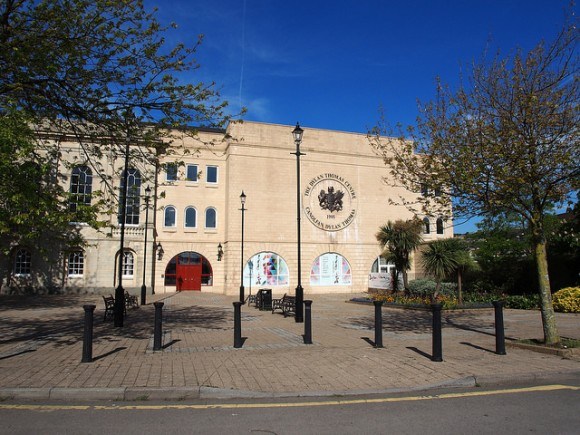
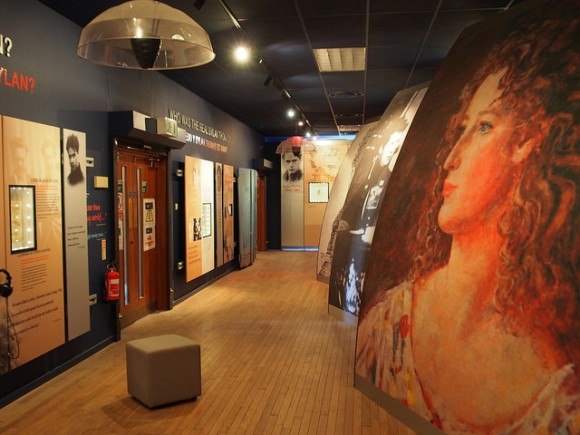
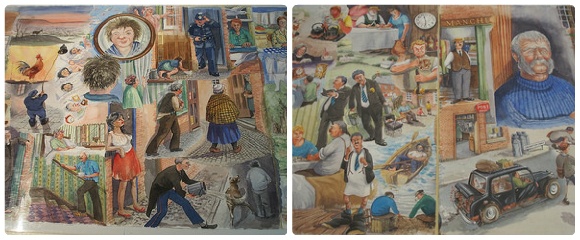
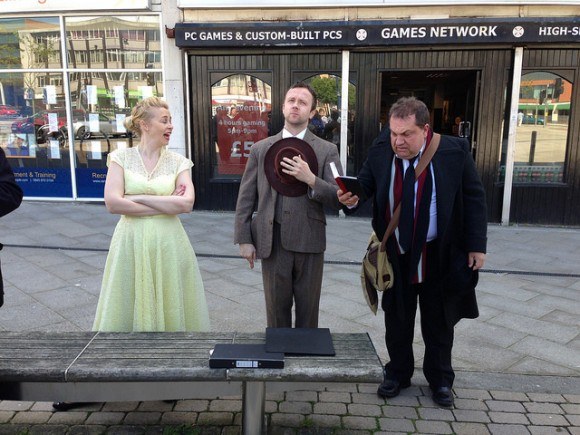

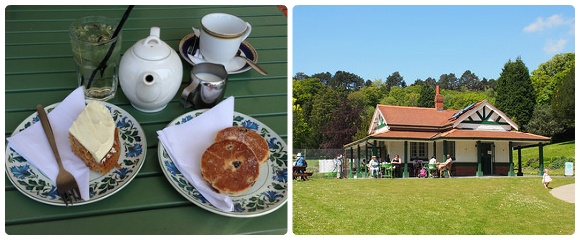
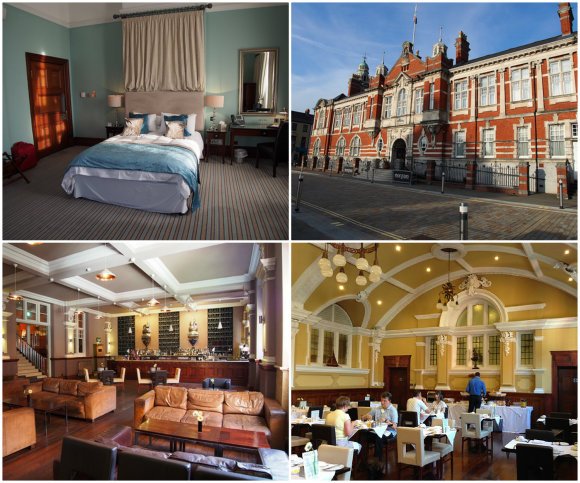

Zoë Dawes
Friday 4th of July 2014
Fascinating article Heather. You shed a lot of light on Dylan Thomas and his writing. I remember reading 'Under Milkwood' at college, hearing the sonorous Richard Burton bring it to life on the radio and a play on TV about his last days (with Tom Hollander channelling the poet's decline very graphically) but this has added another element. The performance sounded good too :-)
Heather Cowper
Friday 4th of July 2014
@Zoe Thanks, I enjoyed finding out more about Dylan, he was a complex man but the poetry speaks for itself
Hels
Tuesday 24th of June 2014
I had a wonderful time in Swansea but I could not remember the Dylan Thomas Centre. Of course! Although city's Guildhall was old (1825), the Dylan Thomas Centre is actually quite new (1995) and it wasn't yet open when I was there. So thank you for the link
Hels Art and Architecture, mainly http://melbourneblogger.blogspot.com.au/2009/12/dylan-thomas-literary-pilgrimage-to.html
Heather Cowper
Tuesday 24th of June 2014
@Hels yes I think that it's only in recent years that Swansea has been celebrating Dylan Thomas and encouraging visitors to visit Swansea on his account